
A. The windmill is the first generator of energy. The windmill must be put over 5 meter high to be reliably effective, because the higher up it is mounted, the more wind it catches. When we sail upwind, the windmill always works great and delivers enough to compensate the loss of the waterpropellers. Learn all about it…
B. The Autoprop propellers are set in vane mode when we sail slowly. But as soon as our speed through the water reaches 5 knots or more, we use them for hydrogeneration. Autoprops are adjusting continuously to the most efficient propeller pitch and transfer rotational power to the alternator. These alternators are the electric engines, but we switch them to the generation mode as soon as we sail. This way, we generate hundreds of Watts when making good speed. Learn all about it…
C. The Fibercon sails make the real motor. They can generate over 20 kW of power. The sails deliver the speed to make the Autoprops and alternators run. Especially when the wind is light, we have to mention the Parasailor. This sail empowers the yacht in an easy going way and gives her a continuous 5 knots or more, enough to make the Autoprops deliver good energy.
D. The carbon masts (main mast and mizzen mast) are much lighter than the regular aluminium masts. This saves a great amount of weight. Every kilogram less in the top of the mast saves 34 kilograms of ballast. So the boat remains light and it is easier to make good speed.
E. The big windows bring a lot of light inside, and, more importantly, when the sun is low, they let in a lot of heat! About 80% of the sunlight converts into heat. This happens with every morning and evening sun, just when it is colder, so when we need it most. Nice in the morning and it saves a lot of extra heating in the evening.
F. The solar panels work as biminitop over the cockpit. They are thin and cool well, so they work great, also in the tropics. Learn all about it…
G. The (walkable) panels on deck can’t cool well, but they kick in when in Northerly latitudes, where you also need them. The side solar panels in the windows are mounted where no view is needed in e.g. the toilet or a cupboard. Learn all about them.
H. The hull skin is made of foam and glass/vinylester. On the inside, an extra 11 centimeter of PIR foam is applied to the skin. Now we have an insulation comparable to a house with insulated cavity walls. We hardly need energy to heat up in the evening. Learn all about it…
I. The Lithium Ferro Phospate batteries replace the lead acid ones. They contain the energy, normally consumed by an average European family in an average week (about 50 kWh ). If there is no wind and you need to go to the shore, you can motor 48 hours making 2 knots. The batteries weigh a lot and this helps for the stability – it saves us lead as ballast.
1. The navigation lights are LED lights of LOPO Light. They reduce the energy with more than 80% compared to the ‘yellow’ argon light, or 40% compared to halogen light. These LEDs have about 50.000 working hours, are much smaller, and lighter, which is beneficial for the stability that high up in the mast. [/su_column]
2. The broadband radar consumes 40 to 50 times less energy and is 3 times lighter than the regular pulse radar. And, when switched on, it directly starts working. A great radar for sailors, especially leisure sailors.
3. The two electric engines deliver 6,5 kWatt each (together about 19 HP) with about 90% efficiency to the Autoprop propellers. The self pitching Autoprops are the most efficient props, according to various research in sailing magazines. They can save you up to 70% of energy in your propulsion. But more importantly (see B), when sailing, we switch the electric engines to alternators and also then the Autoprops run in the most efficient generation mode.
4. The navigation equipment consists of a sounder, log, wind meter, GPS, AIS and the low consuming broad band radar, all shown on a plotter in the cockpit. All this is using 30 to 50 Watt. Separately we have a second system on a tablet, showing AIS, GPS, which is good on the ocean and consumes 5-15 Watt.
5. All interior lights are LED. Most lights use 2 or 3 Watt, so it hardly consumes energy.
6. The induction cooker can take 3500 Watt. This is a heavy user, but always 50-55% less consuming than a regular propane/butane cooker. It saves a lot of humidity and moist, see the Heating chapter. And no gas on board is much safer.
7. The ‘hay box’. As soon as our rice, vegetables or pasta cooks, we take it from the induction cooker and put it in the ‘hay box’. This is an insulated drawer (not shown in the drawing). This way, we let the food cook in its own heat till it’s done. Safe, and we now cook with an 80% reduction of energy!
8. The microwave oven is great to quickly heat a meal. With its efficiency of 70%, it is far more sustainable than using a frying pan to heat up your bite. There is also a regular oven in it. Great as a stove, but if we want to make a bread, we use the bread baking machine, which is 3-4 times more efficient.
9. The water cooker has a level indicator, which is the best invention to save water and energy. The cooker takes a lot of power, about 2000 Watt. Because it is double insulated, nearly all the energy goes into heating the water. So the water is heated quickly, and we use only 20% of the energy that you use when taking a kettle on a gas stove!
10. The fridge/freezer is much better insulated compared to normal fridges or freezers, especially the ones in yachts. The box is completely packed in about 15 cm of PIR foam (high quality foam). The compressor is the smallest on the market and can use 50 Watt, which it scarcely takes. Because of the thick insulation, the fridge/freezer stays a small, neglectable user, also in the tropics. Anecdote: Originally we meant to design a fridge only, but when testing, all our food froze! So we split the box into a freezer/fridge.
11. Power electronics consist of the Studer inverter/converter, combined with the Battery Management System of EV Europe . A display shows direct, clear information. People get it in basic simplicity and believe it or not, the funny thing is that the numbers on the display make people aware of the energy, or even into real fossil free addicts.
12. On board is a separate washing water and potable water system. The deck of the Ya is one rain catching area, and the water can be drained to the washing water tank. From there, we can press the fresh rainwater through a silver ionizer to preserve it and then store it in the drinking water tank.
Specifications Sustainable Yacht
| Type | Sustainable Yacht | |
| Length | 10.10 m | 34.5 ft |
| Beam | 3.96m | 12.8 ft |
| Draught | 0.70/2.70m | 2,3/9 ft |
| Displacement | 8,5 tonnes (empty); 10,5 tonnes max | |
| Material | vinylester/glas on foam | |
| Airdraught | 17,5 m | |
| CE approval | A (Ocean) | |
| Mizzen | 5 m2 | |
| Mainsail | 38 m2 | |
| Staysail | 20 m2 | |
| Jibb | 28 m2 | |
| Genaker | 68 m2 | |
| Parasailor | 104 m2 | |
| Storm jibb | 6 m2 |
General Plan
Stability Plan ……………….Sailplan ……………………Line Plan………………… Polar Diagram
Energy Balance ……………. Datasheet Energy
The Energy Balance
In the PDF ‘Energy Balance’ up here you find the very basis of the way to live (and cruise) fossil free. Here under you find several in-depth articles how the Ya and crew do it in detail. We start with the Use only What You need articles, where we lower some 70-90% of the energy. The big chunk.
Now when it is only this little energy we finally need, the generation is feasible. So we treat the generation int the latter chapters.
On the last use-only-what-you-need-cooking blog, we got various reactions, and all good. So, are you ready for the big one? Sailing. With sails, not on the engine. If you only use the engine when you need it, the pay off is great in the experience on comfort, safety, sailing pleasure and experiencing nature.
The key to most of it is the planning, so about good weather forecasts.
Use only what you need – You
All guests on board of Ya automatically start living and acting using less energy. Regardless of age or background. Of course, Ya’s design and devices like the watercooker make it easy. But, in two or three days, the guests start living and acting in a more sustainable way, without having been told. They only use what they need. A miracle? All pre-biased?
Here we explain how people, like you, change.
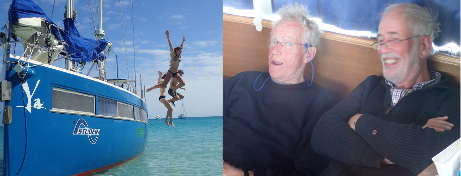
Much rewards mixed with a little threat
If you cook water for tea on board ‘Ya’, the electrical cooker cooks it within a minute. A kettle on a gas stove would take 3 to 4 times longer. And, the electrical cooker doesn’t heat the cabin with lots of steam finding its way to your ceiling and your bed linen. So, this is rewarding.
The same reward you get when using the induction cooker. It is straight forward: the energy goes only to the cooking, safely, without hindering side effects. The haybox gets a pan out of the way and makes cooking more relaxed.
Using the well-insulated fridge and freezer, all the same. Of course you always close the lid after opening it. The fridge works without the disadvantages that most yachts experience because of bad insulation. So, the diesel engine has to run for an hour to refill the batteries, sucked empty by these fridges. Not on Ya.
When we use the engine for propulsion, the electric engine gives no noise, no fumes, it is all peace and quiet.
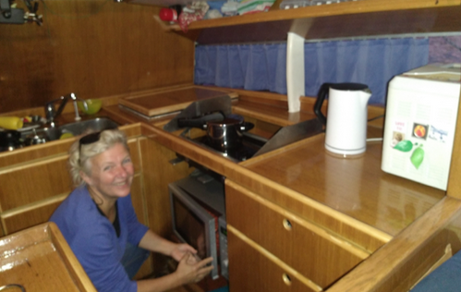
Who would not appreciate all this positive impact? The funny thing is: if your environment is rewarding and positive, you want to keep it this way. So, people get interested.
And, knowing that we regenerate all energy ourselves by solar, wind and hydro, people want to know how much the equipment takes on energy. Because you don’t want to lose, you want the energy to stay in balance. The idea of an empty battery bank -although never happened in Ya’s seven years existence- creates a threat that keeps you away from this downside.
The display and us
You start a car and you watch the display. You make speed, you check the display. In winter at home, when you feel chilled, you check the temperature display. On a building you see a display with the time you already know, and the temperature you already know. Why do we watch? Because you want to be sure. And because there might be changes, and you want to know all about it. So, a display attracts our attention.
In most yachts, the energy displays are put away in the ‘Engineering Corner’. Often they show abracadabra like ‘Ah’ or ‘Amp’, with numbers in a small print.
Lucky us: we have one with the W of Watt and everybody knows that a 10 W light bulb uses 10 Watt power. And the numbers are in big print. We mounted the display on a central place in the cabin, visible from all seats and corners.
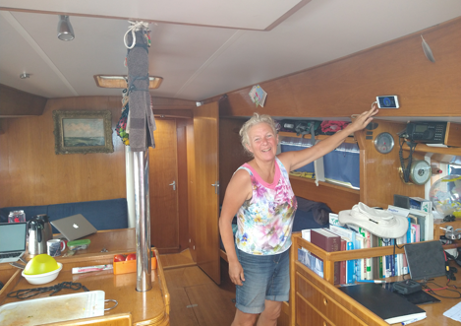
Do you want to see for yourself how this works? We put together different screenshots that make clear how much energy we use and get, in which situations.







Once a new guest just switched on the water cooker and she asked: “Peter, kW, that means kilowatt, doesn’t it?” Because she was surprised that a water cooker used so much. She always thought that the lights were the big users. She learned that on the energy for one pot of tea, you can switch on all LED lights on board the Ya for one week.
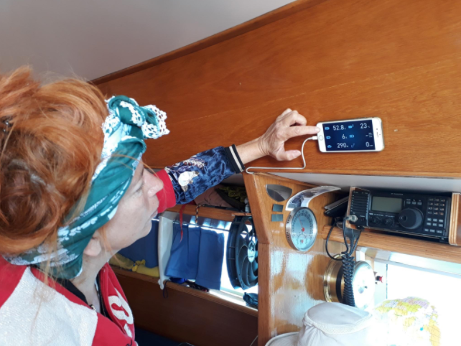
Make money with your display at home
Your energy display at home is put in a closet, often even without a decent door knob, so you only look at that meter incidentally. At the end of the year you get a bill from the supplier and then you think: “Now really, this year I want to use less.’ But again, a year later… the supplier has sent another bill and he is the only laughing one.
Our friends got solar panels. They then asked the company to put the display outside the meter closet. Every time they were near, they read the display. What comes in, what goes out. They learned to interpret it. A sunny day, was a good day. When her son came home from school, he could see that Mum had a cake in the oven before he could even smell it. The family talked about what costs energy and what saves energy. You know what happened with the use? They used 40% less since then.
So, if you want to save money, and some of the environment for your children, mount your energy display where you can see it!
Use only what you need – Sailing
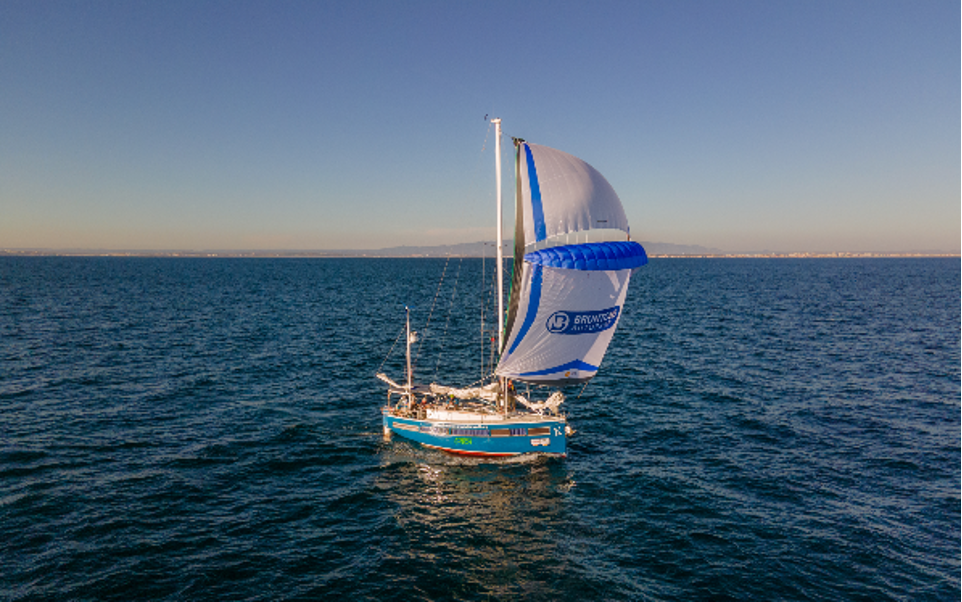
Planning according to the weather forecast
30 years ago, a weather forecast could be: “During the day the wind will be South west to North West 2 to 3 Beaufort, in open area up to 4 or 5 and in showers 6 Beaufort” So basically, you didn’t know more than that the wind could be Westerly, between 2 to 6 Beaufort. So you hardly planned for the weather, you just decided on the day itself.
Nowadays we have great weather forecasts, in with wind angles per degree, and speeds in knots or m/s. All this with great accuracy over 5 days ahead. We take profit of that bij planning our voyage. When we make trip for a weekend, we decide about our routing depending the forecast. Never more the wind against you!
But still we meet sailors making appointments first and afterwards checking the weather. Once we heard a story of people sailing an 8 days round trip. They constantly motored, 5 knots for 600 miles, beating against waves and winds – and actually could set sails for a mere 100 miles. Terrible. Their appointments happened to be made contrary with the weather. This is not only a waste of fossil fuel, money and CO2, but also bad for your health, your precise leisure time, and the extra CO2 is bad for your childrens future.
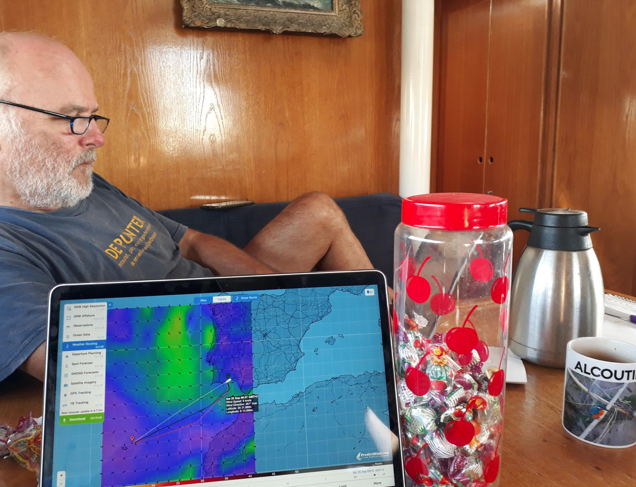
With the use of a weather forecast instead of the diesel engine, they would have sailed the other way around would have led to a joyful trip with only 100 miles motorsailing and 700 miles of sheer sailing pleasure.
So do use the engines only when you need it. It gives sailing pleasure in stead of banging your boat into waves and wind.
A modern yacht
The Ya is a modern yacht. She is not heavy, and you can feel her sailing. This makes the sailing fun. Especially with light winds we enjoy sailing in all its subtleties. And then we are surprised to see so many modern yachts going on the engine., even with 5 knots of speed. That’s a pity, they miss the best part! Perhaps they like the motoring? Well, then buy a motor yacht.
And in heavy weather, if you use the engine instead of sails, you miss the safe part. Because a sailing yacht is designed and built for sailing, and not for heavy engine use.
So, on our modern yacht, we use the engine only when we need it. And we get more sailing pleasure out of that.
“When necessary”, and reliability
Many skippers tell me they want the engine to be there ‘when necessary’ and often they mean: to resist a storm. From the shore point of view this sounds reasonable. But sorry, in the four occasions I was in a storm, the diesel engine let us down three times. Once it was the sludge from the tank, stirred into the diesel by the pounding waves, blocking the fuel filters. Once it was sea water splashed through the exhaust pipe into the engine and stopped the engine, and once it was some wet or broken electronics on the engine. On these occasions, it was the reefed sails that helped us out and brought us to safety.
Only the fourth time, it was in Force 9 on an old-fashioned sailing lugger, we ran the old engine for comfort purposes. On board was a dedicated engineer for the maintenance. But, also in this case, we relied on the sails to get us from Bermuda to the Azores safely.
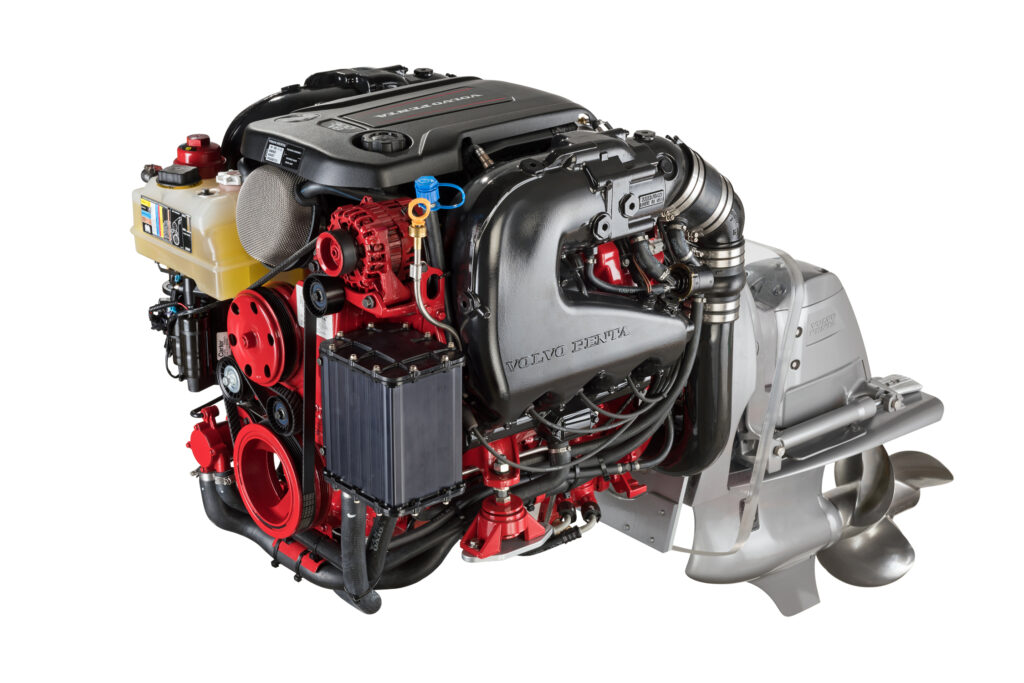
Realize that you need to know an awful lot of a diesel engine before you can oversee what can be the cause of a defect. And, even of more value: how you can prevent defects. If you are a yacht skipper and you are not a yacht engineer yourself, please do not count on the engine, especially not the complex, computerized engines. Focus on your sails and your sailing for reliability. And, with a wink: also don’t use more sails than you need.
So, we sail, also in heavy weather. Perhaps we will use our electric engines as auxiliary in a storm. To give a little bit of extra propulsion and make our leeway smaller. The chance that electric engines will work in stormy circumstances is much bigger, because:
- Salt, water or moisture don’t affect the watertight engines and controllers
- They are not sensitive to moving and shaking
- There are hardly moving parts (only a rotor and shaft)
- In general, they are maintenance free.

Electric engines and controllers are closed and free of moist, saltwater, oil. The mean time between failure is large and the maintenance is many times smaller than for a combustion engine.
“Range”
Often yacht skippers ask for the range on the engine, with our battery bank, our ‘fuel tank’. Their yacht has a 200 litres diesel tank and they can sail 300 miles with it. They say. But they never tested it, so I think in the first storm it will stop within 3 miles. They had better set sails.
And honestly, I don’t know what our “range” is. Our Fibercon sails already did 40,000 nautical miles. O, you mean the engines? We never did, but we can use the engines for 2 days on 2 knots on a flat sea, so that would be 100 miles. So we can reach any wind still harbour or bay. But we like sailing. Even with a tiny bit of wind, we can motor sail endlessly with a little bit of power, as long as we have a little bit of sun in the solar panels to feed the engines. We love it and a guest once called it ‘sun sailing’. You feel with your ship a part in balance with nature.
We have another view on the “range”. For more energy we like some distance to sail, because next to the solar and wind energy, we use the electric motor as alternator. When we cross a sea or a part of the ocean with some range, we enter the harbour mostly completely fueled, with (almost) 100% full batteries. We are quite happy with this range. 😉
Manoeuvring
We intend to use our two engines to manoeuvre us from a harbour straight towards the sailing area. Marinas are designed very space efficient; manoeuvring your yacht on sails into or out of a box is virtually impossible. But when out of the marina, we hoist a sail.
When we go anchor up and we have some space, we enjoy to manoeuvre ourselves out sailing. The engines are stand by (electric engines are always stand by, come to think of it), and sometimes we use them for some seconds. And this feels a bit like a loss, because we like the sailing.
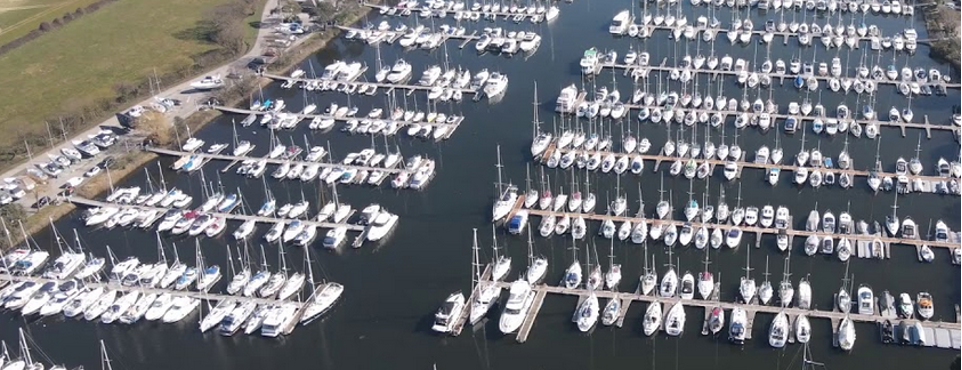
River sailing; 2 knots through the water is our leisure speed
Sometimes when we are inshore and we want to travel further on a river with no wind or against us, we use the engines. We sail with the tide then, and make about 2 knots through the water. Why 2 knots?
First, we go with the tide, so the current adds it up to 3 or 4 knots. Second, we don’t want to make miles, there is no target. And if so, we are there already: on our yacht on a river, enjoying, sight-seeing, exploring, discovering.
Third reason is that we don’t hear our silent engines at all anymore. Ever sailed on a river in complete silence, with just the sound of a bird, a bee, a fly? Last reason is that we want to make sure we always have enough energy left for the unexpected. Like we do with our water, our food, everything. And just for the sheer beauty of physics: did you know that doubling your speed means you use a staggering 2 X 2 X 2 times, is 8 times more energy?
Main thing is the philosophy: we only want to use what we need. So, this is about getting more; not about ‘using less’. We experience nature more and we feel in balance with our environment.

Use only what you need – cooking
Last blog we promised to show you that we only use the energy we need. First we show the use of our equipment in the galley, the ships kitchen.
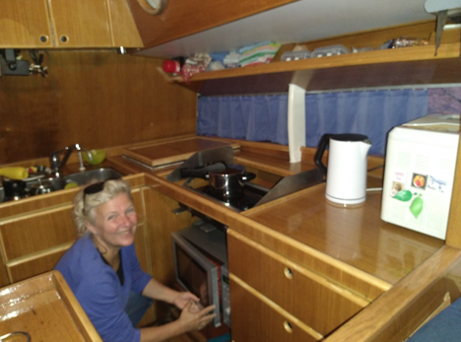
Heating water
Before Ya, we always used a kettle and a gas stove to heat the water for our coffee and tea. The heat of the flame and fumes go around the kettle and… are still hot over the kettle. That heat is all lost.
Now we use a water heater, a cooker. Let us have a look:
- If you poor water in, you see a level meter. So you only cook the water you need.
- The heating element is built in the bottom, and the water is surrounding the element, thus giving all the heat to the water to be cooked. So you only use the energy you need.
- The body of the heater is double skinned so insulating well. The heated water stays hot and there is hardly ‘leaking’ heat through it.
- It cooks that fast, that there is hardly time to ‘leak’ heat.
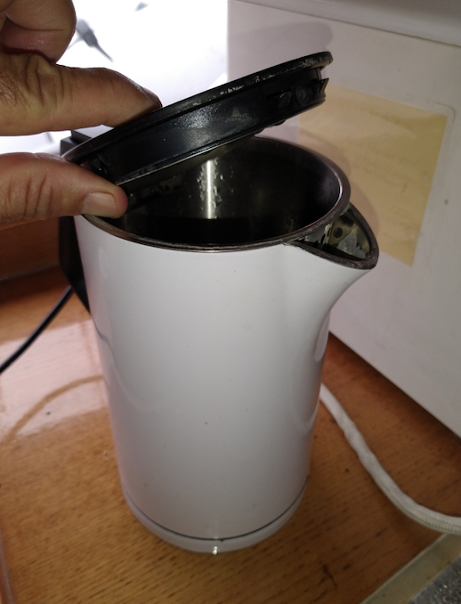
Compared to the kettle on the gas stove, we save about 80% of the energy. While we only use what we need with the electric heater, the energy created by the gas combustion however, ends up in the form of warm fumes. You cannot use it to heat up your room, because the fumes consist of water damp and the CO2. So, this means you must ventilate your room well, for your own health and to keep your room free of moisture.
Cooking with induction and hay box
The induction cooker is high tech. The induction technique gives energy through a (safety) glass to the steel bottom of the pan, and then that pan bottom gets hot. That place is exactly the place where you need the heat. The induction cooker saves you about 50 to 55% of the heat if you compare it with cooking on gas stoves or the old fashioned electric heating stoves.
But we can do better. We go from high to low tech. In Grandma’s time, before we had the overflow of fossil fuels, everybody was careful with the fuels, because they were costly. So, Grandma cooked her rice, her vegetables and pasta in a pan, and the moment it was hot, she took it from the fire and it went straight in the ‘hay box’
The hay box was a box with hay. It insulates. It kept the heat in the pan. The rice, potatoes or vegetables were cooked slowly. Most food is cooked well 3 times longer than when you keep on cooking it on a stove.
On a moving ship it has the extra advantage that the hot pan stays in a safe place.
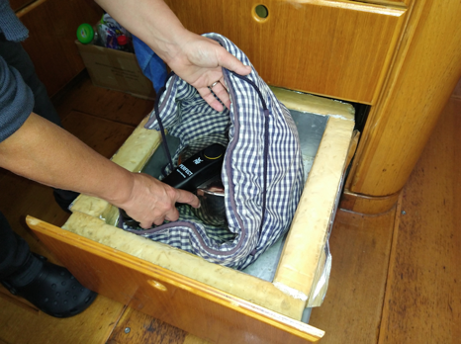
We modernized it a bit. We took PIR foam, put it in a drawer, and with the pan inside we cover it with a sack filled with modern soft foam. This modern ‘hay box’ saves us energy again. We save another 30%.
So,when we cook with the induction cooker and hay box we can easily use 20% of the energy we used in the old, fossil days.
What do you use?
Heating up in the micro wave
About 70% of the electricity is converted to little radio waves. These radio waves make water molecules move. By moving and colliding, there is friction, and friction makes heat.
It means that the water in the food gets hot. Water is generally the main part, so your food gets hot ‘from the inside’.
Compared to a pan, this is ideal to heat up food. Because you don’t have to heat up a pan first, and when mixing the food in a pan, the lit is off, so much heat flies away. Most of the heat flies away then. But microwave uses 70% of the electricity input to really heat up your food. That is a loss of only 30%.
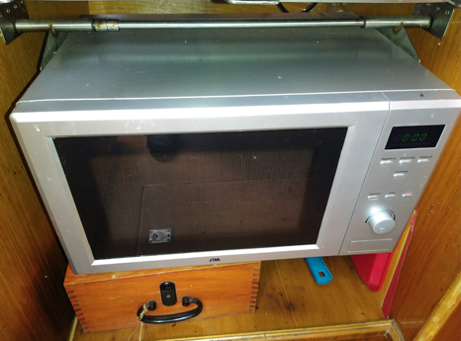
Bread baking machine instead of an oven
For small, private use, the oven is a real energy consumer. But we like fresh baked bread. Therefore we do it in the bread baking machine.
The old-fashioned way with kneading the dough, etcetera, costs you personally a lot of work and energy. Not with the bread baking machine. You simply put the water, flour, salt, yeast et cetera in the pot, push some buttons and off the machine goes. You use only your energy what is really needed. Just as the thing itself.
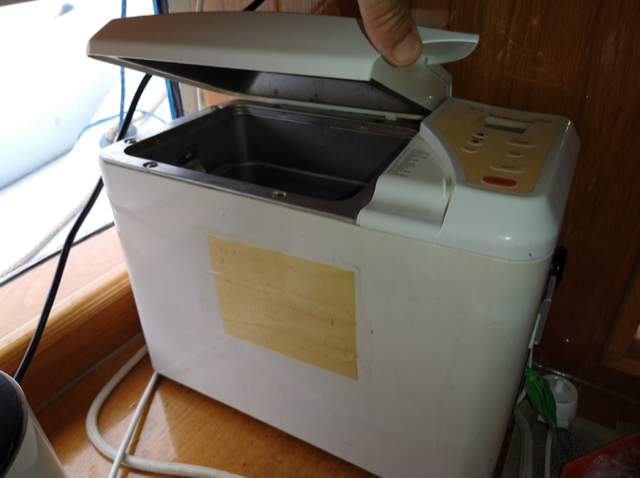 We tried to measure the difference in energy use between oven and bread baking machine but did not succeed precisely. But clear is that the bread baking machine saves about 30%.
We tried to measure the difference in energy use between oven and bread baking machine but did not succeed precisely. But clear is that the bread baking machine saves about 30%.
The fridge and the freezer
If you only want to use what you need when cooling (and heating), only 3 things are important:
- Insulation
- Insulation
- Insulation
So that is what we did. Our refrigerator is surrounded by a 12 to 15 centimeter pack of PIR foam. Now we only use a tiny bit of energy. So little, that we even don’t notice it in our energy household. In the tropics and subtropics the 50 Watt equipment runs on 3 to 4 times an hour for 6 minutes. For the 35 liter fridge we note about 2-4 degrees Celsius, and for the 25 liter freezer we sometimes hit the 11 degrees.
Please don’t believe designers design a good fridge or freezer for you. They ‘economize’ on the insulation, to ‘give’ you more space for cooling. So these things need a real powerful cooling device. The designers design this thing right under your refrigerator. So the heat exchanger under it heats up your fridge again. To get all this idiotic power design effective, the cooling equipment has to be extremely powerful. It is about 4 or 5 times stronger than what we need for our complete fridge and freezer.
Sorry to tell you, but on the market we only found bad refrigerators and freezers. On sailboats you see that many skippers, aware of their limited energy and batteries, become the slave of their badly designed fridges. They run the engine 2 times a day to make electricity. Or they buy an enormous surface of solar panels, to compensate the superfluous loss of energy the fridges make. It is like filling up a colander with water.
This is why some yachties simply stopped using these “energy guzzling devices” and now do it without. A pity! We love cold yoghurt, a cool beer, cheese and a beattiful piece of cured Spanish ham.
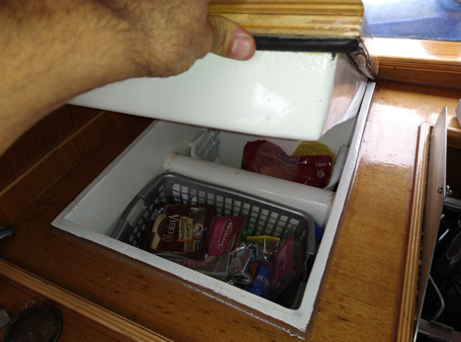
Our fridge and our freeze box (just visible) are an arm length deep. The lit of our freezer is on the top and insulated with only 8 cm PIR foam, and the box itself with 15 cm. We don’t know how much energy our fridge and freezer takes, because it is too little.
The extra comfort of using only what you need.
Our galley, our kitchen, is widely appreciated for its comfort. Making tea water is done 3 times quicker than usual. The induction cooker is easy to use and safe. The microwave is an easy equipment, and the bread baking machine a feast.
We have no gas, so no fumes or damp (moist) getting into your upholstery. It brings comfort.
We have no danger of too much fumes in a small space (Carbon Monoxide). We have no gas, so no risk on explosion or fire. So this is safer.
And by the way, we have no costs for the gas, and all equipment is cheaper than the same as gas equipment. On the other hand, we needed to invest in an expensive inverter, to convert the battey power to the 230Volt this equipment needs.
This way, we have reduced the energy use about 70-90%, so then it matters to generate it with renewables energy (solar, wind, hydro).
Use only what you need -You
The Heating Management (and cooling)
When it gets colder we have, until now, been able to manage with the incidental use of an electric radiator of 400 Watt. When it freezes outside we can do our evening with a 150Watt infra red lamp under the table and a warm water ‘pillow’ in the back.
Most yachts have then a full working diesel heater. We don’t need that because of three things:
1. Insulation
2. Insulation
3. Insulation
1. Insulation – a lot, and neatly built in
Before we started with the carpentry, the hull of the Ya was insulated. This was done very precisely with high quality foam, called PIR foam (not PUR!). The stiff foam is built up in 2.2 cm layers up to 11 cm thick. Every foam plate is tightly closed to the other, so there are no heat leaks.
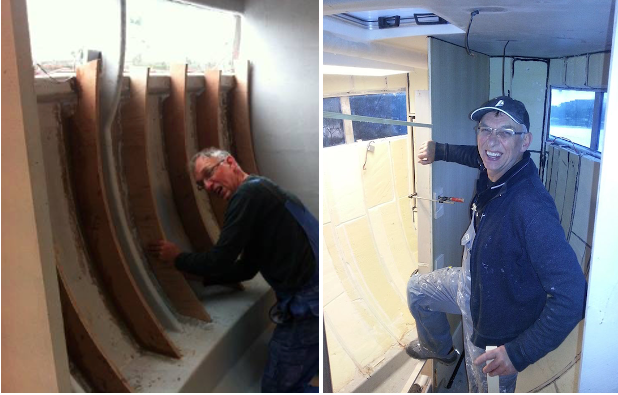
2. Insulation – PIR as an affordable quality foam
How good is this PIR foam? Well, it is a great insulator and very affordable, and it is self-retardant, so it slows down fire. In the table below you see some numbers.
The Lambda number says how many Watts of heat goes through the material if it is 1 m thick and when there is 1 degree (Celsius or Kelvin) difference on each side. So, the lower the Lambda, the better the insulation. As you can see, the very expensive Vacuum Insulation is doing best. The PF Quod Core (0,015) is second best, but it can only be applied flat, and it is rather expensive. And the third best is PIR: this can be used on yachts. It is also self retarding. Materials like cork or expanded clay are doing much worse. Better not use them on yachts, they also weigh a lot.
On board of steel yachts, often glass wool is used. It is easy to put it neatly in any corner. But, once wet, it insulates only as good as the water in it. And it can go down and hang, a disadvantage. When it is dry, it insulates OK. But PIR does that better and PIR can’t take water (condensation). Disadvantage of PIR is that you need to work very precisely. Every open seam is a heat leak and that also creates condensation.
The final column in the table shows the resistance value (R-value). As the Lambda is a theoretical number, the R-value shows the effective heat resistance when the insulation is used in houses, caravans, boats. The higher the R-value, the better. It confirms that PIR is the best affordable choice.
| Material | Average Lambda | R-value for 100mm thickness |
| W/(m-K) | M2K/W at 100mm | |
| Brick (sand lime) | 0,8 | 0,125 |
| Glass fibre | 2,5 | |
| Core cell foam | 2,6 | |
| Glasswool | 0,036 | 2,63 |
| Rockwool | 0,036 | 2,6 |
| Cellulair glass | 0,044 | 2,78 |
| Expanded clay | 0,044 | 2 |
| Hay | 0,05 | 2 |
| Cork | 0,039 | 2,5 |
| EPS | 0,027 | 2,75 |
| XPS | 0,027 | 2,85 |
| UF | 0,043 | 2 |
| PUR | 0,027 | 2,6 |
| PIR | 0,021 | 4,4 |
| PF/ Quad Core | 0,015 | 5,56 |
| Vacuum Insulation | 0,0042 | 23,8 |
3. Insulation – to get comfortOn Christmas night it was minus 3º Celsius.
We were having a Corona-proof dinner with some fellow-sailors. It was nice, we had fun, lots of olives and almonds, little alcohol and no heater Then, our friends asked where our heater was. Well, somewhere packed deep down in a bilge; we can’t remember using it. Yet, the atmosphere on the Ya felt as comfortable as in a house, or even better. How is this possible?
Now, let us compare the insulation of the Ya with that of a normal house built in the 80’s (so after the first oil crisis and after the book ‘Limits to Growth’. How well is it insulated? Or, to put it technically: What is the heat resistance of the house’s walls and the Ya’s skin?
Suppose you live in a house with brick cavity walls and 5 cm of rockwool insulation. The two layers of 10 cm bricks each have an R-value of 0,125. So, this is 0,25 in total. 10 cm of rockwool has an R-value of 2,6. Your house has 5 cm, with an R-value of 1,3. So, for the house the total R-value is 1,3 + 0,25 = 1,55 which is the total heat resistance of your wall.
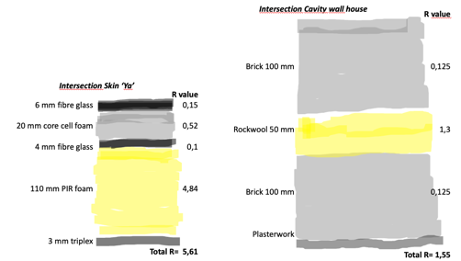
Now the Ya
The skin of the Ya is made of 6 mm of glassfibre, 20 mm of core-cell foam, then 4 mm of vinylester/glassfibre. In addition, on the inside the skin is covered with 110 mm PIR foam.
So, the skin has glassfibre (6mm +4 mm) 10 mm. The R-value of 10 cm is 2,5, so the R-value of 1 cm = 0,25. It also has core-cell foam 20 mm. The R-value of 10 cm is 2,6, so the R-value of 2 cm = 0,52. On the inside: PIR foam 110mm. The R-value of 10 cm PIR is 4,4, so the R-value of 110 mm = 4,84. So, for the Ya the total R-value is 0,25 + 0,52 + 4,84 = 5,61.
The total heat resistance of the skin of the Ya is more than 3 times higher compared to an average Dutch insulated house. No miracle Ya keeps it warm inside in wintertime.
4. Extra: Cooling management, or the freezer and fridge
When cooling, the same 3 things are key:
1. Insulation
2. Insulation
3. Insulation
So that is what we did. Our refrigerator is surrounded by a 15 centimetre pack of PIR foam. The bottom has more than 20 cm of PIR insulation, and the lit, where the cold exchange is less, only 8. Now the cold stays en and we only use a tiny bit of energy. So little, that we even don’t notice it in our energy household.
In the tropics and subtropics, the 50 Watt equipment runs on 3 to 4 times an hour for 6 minutes. For the 35 litre fridge we note about 2-4 degrees Celsius, and for the 25 litre freezer we sometimes hit the -11 degrees Celsius.
Please don’t believe that designers automatically design a good fridge or freezer for you. They ‘economize’ on the insulation, to ‘give’ you more space inside. So, then you need a really powerful cooling device. The designers may well design this device right under your refrigerator. So, the heat exchanger there under it heats up your fridge again. To get all this idiotic power design effective, the cooling equipment has to be extremely powerful: about 4 or 5 times stronger than what we need for our complete fridge and freezer.
Sorry to tell you, but on the market, we only found ‘energy-guzzling’ refrigerators and freezers. On sailboats you see that some skippers, aware of their limited energy and batteries, have become the slave of their own badly designed fridges. They run the engine 2 times a day to make electricity. Or they buy an enormous surface of solar panels, to compensate for the loss of energy by the fridge. Energy wise, it is like filling up a colander with water.
This is why some yachties simply stopped using fridges. A pity! We love cold yoghurt, a cool beer, tapas and the left over. So, we cool only what we need.
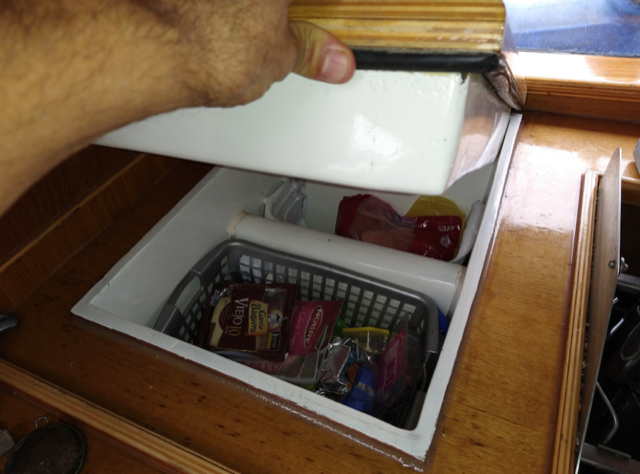
Use only what you need – Sailing
On the last use-only-what-you-need-cooking blog, we got various reactions, and all good. So, are you ready for the big one? Sailing. With sails, not on the engine. If you only use the engine when you need it, the pay off is great in the experience on comfort, safety, sailing pleasure and experiencing nature.
The key to most of it is the planning, so about good weather forecasts.

Planning according to the weather forecast
30 years ago, a weather forecast could be: “During the day the wind will be South west to North West 2 to 3 Beaufort, in open area up to 4 or 5 and in showers 6 Beaufort” So basically, you didn’t know more than that the wind could be Westerly, between 2 to 6 Beaufort. So you hardly planned for the weather, you just decided on the day itself.
Nowadays we have great weather forecasts, in with wind angles per degree, and speeds in knots or m/s. All this with great accuracy over 5 days ahead. We take profit of that bij planning our voyage. When we make trip for a weekend, we decide about our routing depending the forecast. Never more the wind against you!
But still we meet sailors making appointments first and afterwards checking the weather. Once we heard a story of people sailing an 8 days round trip. They constantly motored, 5 knots for 600 miles, beating against waves and winds – and actually could set sails for a mere 100 miles. Terrible. Their appointments happened to be made contrary with the weather. This is not only a waste of fossil fuel, money and CO2, but also bad for your health, your precise leisure time, and the extra CO2 is bad for your childrens future.

With the use of a weather forecast instead of the diesel engine, they would have sailed the other way around would have led to a joyful trip with only 100 miles motorsailing and 700 miles of sheer sailing pleasure.
So do use the engines only when you need it. It gives sailing pleasure in stead of banging your boat into waves and wind.
A modern yacht
The Ya is a modern yacht. She is not heavy, and you can feel her sailing. This makes the sailing fun. Especially with light winds we enjoy sailing in all its subtleties. And then we are surprised to see so many modern yachts going on the engine., even with 5 knots of speed. That’s a pity, they miss the best part! Perhaps they like the motoring? Well, then buy a motor yacht.
And in heavy weather, if you use the engine instead of sails, you miss the safe part. Because a sailing yacht is designed and built for sailing, and not for heavy engine use.
So, on our modern yacht, we use the engine only when we need it. And we get more sailing pleasure out of that.
“When necessary”, and reliability
Many skippers tell me they want the engine to be there ‘when necessary’ and often they mean: to resist a storm. From the shore point of view this sounds reasonable. But sorry, in the four occasions I was in a storm, the diesel engine let us down three times. Once it was the sludge from the tank, stirred into the diesel by the pounding waves, blocking the fuel filters. Once it was sea water splashed through the exhaust pipe into the engine and stopped the engine, and once it was some wet or broken electronics on the engine. On these occasions, it was the reefed sails that helped us out and brought us to safety.
Only the fourth time, it was in Force 9 on an old-fashioned sailing lugger, we sometimes ran the old engine for comfort purposes. But on board was a dedicated engineer for the maintenance. But, also in this case, we relied on the sails to get us home safely.

Realize that you need to know an awful lot of a diesel engine before you can oversee what can be the cause of a defect. And, even of more value: how you can prevent defects. If you are a yacht skipper and you are not a yacht engineer yourself, please do not count on the engine, especially not the complex, computerized engines. Focus on your sails and your sailing for reliability. And, with a wink: also don’t use more sails than you need.
So, we sail, also in heavy weather. Perhaps we will use our electric engines as auxiliary in a storm. To give a little bit of extra propulsion and make our leeway smaller. The chance that electric engines will work in stormy circumstances is much bigger, because:
- Salt, water or moisture don’t affect the watertight engines and controllers
- They are not sensitive to moving and shaking
- There are hardly moving parts (only a rotor and shaft)
- In general, they are maintenance free.

Electric engines and controllers are closed and free of moist, saltwater, oil. The mean time between failure is large and the maintenance is many times smaller than for a combustion engine.
“Range”
Often yacht skippers ask for the range on the engine, with of our battery bank, our ‘fuel tank’. Their yacht has a 200 litres diesel tank and they can sail 300 miles with it. They say. But they never tested it, so I think in the first storm it will stop within 3 miles. They had better set sails.
And honestly, I don’t know what our “range” is. Our Fibercon sails already did 40,000 nautical miles. O, you mean the engines? We never did, but we can use the engines for 2 days on 2 knots on a flat sea, so that would be 100 miles. So we can reach any wind still harbour or bay. But we like sailing. Even with a tiny bit of wind, we can motor sail endlessly with a little bit of power, as long as we have a little bit of sun in the solar panels to feed the engines. We love it and a guest once called it ‘sun sailing’. You feel with your ship a part in balance with nature.
We have another view on the “range”. Last week, on our trip to Madeira we sailed for two days with 25 knots of wind (6 Beaufort) and the only thing we did with our motors was to use them as alternators. So, to fill our battery bank, our ‘fuel tank’. We arrived 100% full. We are quite happy with this range. 😉
Manoeuvring
We intend to use our two engines to manoeuvre us from a harbour straight towards the sailing area. Marinas are designed very space efficient; manoeuvring your yacht on sails into or out of a box is virtually impossible. But when out of the marina, we hoist a sail.
When we go anchor up and we have some space, we enjoy to manoeuvre ourselves out sailing. The engines are stand by (electric engines are always stand by, come to think of it), and sometimes we use them for some seconds. And this feels a bit like a loss, because we like the sailing.

River sailing; 2 knots through the water is our leisure speed
Sometimes when we are inshore and we want to travel further on a river with no wind or against us, we use the engines. We sail with the tide then, and make about 2 knots through the water. Why 2 knots?
First, we go with the tide, so the current adds it up to 3 or 4 knots. Second, we don’t want to make miles, there is no target. And if so, we are there already: on our yacht on a river, enjoying, sight-seeing, exploring, discovering.
Third reason is that we don’t hear our silent engines at all anymore. Ever sailed on a river in complete silence, with just the sound of a bird, a bee, a fly? Last reason is that we want to make sure we always have enough energy left for the unexpected. Like we do with our water, our food, everything. And just for the sheer beauty of physics: did you know that doubling your speed means you use a staggering 2 X 2 X 2 times, is 8 times more energy?
Main thing is the philosophy: we only want to use what we need. So, this is about getting more; not about ‘using less’. We experience nature more and we feel in balance with our environment.

The wind generator
Next to the solar panels and the alternators/propellors, we have the windmill in the mizzen mast.
No matter what windmill you choose, just first consider the thing should be high! The reason is: the higher the more wind. See the drawing here under. Especially the first meters count a lot. Windmills on 2 meter poles – leave it, or buy at least a very cheap one, because it will not work the way you want it.

An old Dutch study for the position of the old fashioned windmills from the 17 th century and on, stipulates that the wind has increased to an effective level at a height of 5,5 meter and higher. So the windmill of the Ya is mounted on the mizzen mast 7 meters above the water. Which is about 6 meters higher than the aft deck.
The windmill of the Ya is marinized and light weight, 6 kilo to be precise. This weight is the only reason that it is not mounted on the top of the main mast. The capsizing angle must remain over 120 degrees (CE-A approval). An alternative place could be on the spreader and then with a spherical fence around it to protect it against the sails. But this fence then again turbulates the wind… And you would need two windturbines, hence the main sail and/or the stay sail is taking the wind away.
Numbers and practice
A good windmill starts rotating at a wind speed of 3 meter per second, which is about 6 Knots. But realise that it produces not even 1 Watt then. Physics laws dictate that with little wind speeds, you can only get little power. A good windmill has an efficiency of about 20%. Betz’s law tells that it cannot get very much higher. The logics of Betz: the more the wind takes on energy, the less the speed of the wind will be.
Generally, you will be happy with a windturbine from about 10-12 knots, so from 4 Beaufort. A good windmill generates 50-70 Watt then. The Ya’s windmill has low noise blades. This costs an extra 200 Euros, but it saves a lot of noise, especially when you don’t want to hear it. You can hear the first light sound at 7-8 knots. Up to 8 knots I often switch it off, because I love silence and you hardly have energy from the mill. Only the Silentwind has a smart thing: it ‘boosts up’ the low voltage and then let it go with enough voltage to really contribute something into your system.
When the wind gets about 15 knots the mill delivers about 100 Watt. The noise would be irritating, but at that level the wind starts to make its noise through the rig, so the noise is relatively no problem anymore. At 20 knots, the windmill’ noise disappears competely in the ambient noise.
Also check the various yield diagrams in the article where we compare the three common used windturbines
The peak power of the 48 Volt SilentWind we have, is 520 Watt. This is in the 8 Beaufort range. At 7 Beaufort it already comes close to the 450 Watt. With more wind, it automatically switches off in its safety mode; the windmill breaks by itself and rotates very slowly then.
Advice is to buy a quality windmill, marinized of course. Silent blades are worth the money on your leisure yacht.
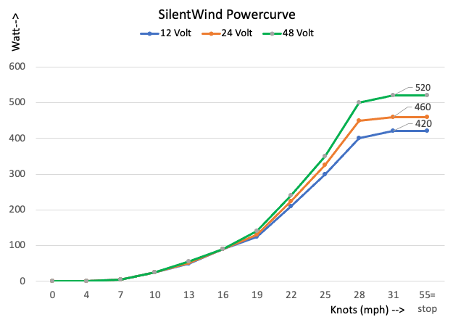
The windmill in the Energy Balance
The windmill on board the Ya is the smallest supplier in comparison with the solar panels and the props/alternators. In the Energy Balance here under you only see the average, which is not very meaningful.
The essence is that the windmill has a complementary function. With little sunshine and much overcast, there is mostly a fresh breeze. So the windmill delivers when the solar panels hardly give energy. And, when sailing on upwind courses, we have to put the propellors in vane position, because we need all the power. Then, with the apparent wind seriously blowing, the windmill makes the lack of the props all good.
| Generation | # | Watt | hr/day | kWh/day | |
| Windmill 400 Wp | 1 | 150 | 20 | 3,00 | this is an average; upwind is much more; downwind much less |
| 4,8m2 Solar bimini 3*230Wp | 3 | 216 | 6 | 3,89 | 30% of Wp during 6 hours |
| 3,6 m2 Solar deck 440 Wp | 3 | 88 | 5 | 1,32 | less power due to heat and shadow |
| 2X 1,2 m2 solar windows 2X60Wp | 6 | 18 | 2 | 0,22 | 2 hrs morning+evening op 30% Wp, 50% shadow |
Please donot focus exclusively on the numbers. In our years of experience we learned that the essence lies in the usage (use only what you need), and for the generation in what I call the tripod of energy generation. The solar panels work together with the windmill and the hydrogeneration (prop and alternator). If it is more cloudy, so less sunshine, then there is mostly more wind, so the windmill and/or the sailing speed makes it good. And, when something fails, there is no big problem, like you would have when you depend on a diesel engine.
The Solar Panels
Next to the windmill and the alternators/propellors (Autoprop ), the solar energy is the third way to create our energy.
Sustainable Yacht the Ya is equipped with solar panels as much as possible. We have three sorts, or sets, on board.
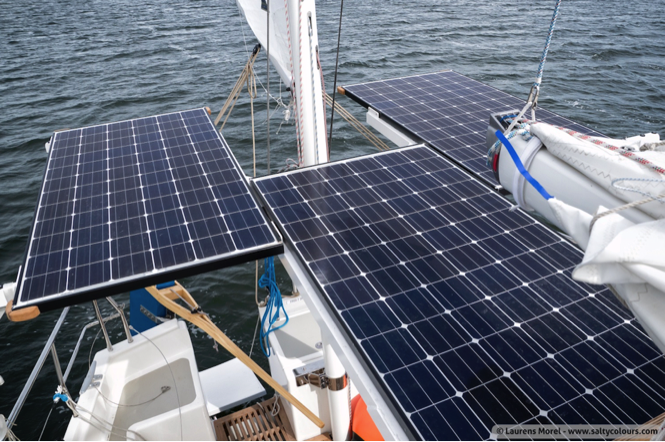
The largest area is the ‘bimini top’ panels above the cockpit, They measure a near 4.5 m2. They are panels with the so-called monocrystalline version, because of the high yield, in our case 20% under ideal circumstances. Then they deliver 720 Wattpeek. This is under a theoretical situation, with the sun shining with a 90 degree angle on them and with a temperature of 4 degrees. A low temperature is needed for a high power; when the monocrystalline material rises in temperature, the conversion from sunlight to electricity gets less. So the biminitop panels are ideal, because they are very thin and on both sides the wind can cool the material very well. Even in the hot tropics they deliver well.
The panels have to deliver a higher voltage than the battey voltage. But if a part of the panels ar in shadow, the voltage will drop. So we made sure that the maximum delivered voltage is high: about 72 Volts. Now if half a panel is in the shade of a sail or so, we still have about 60 Volts, so always higher than the 46 to 54 Volt of the battery.
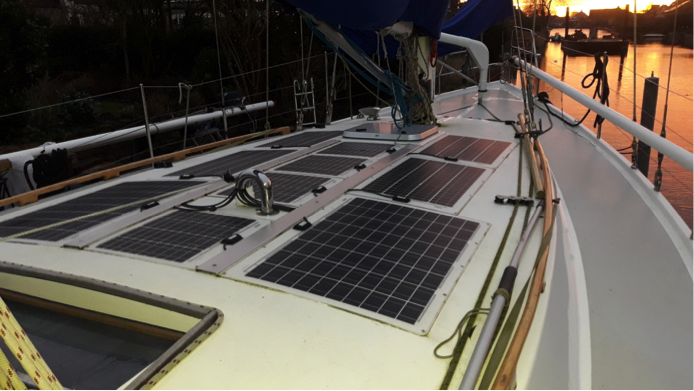
The cabin deck is covered with 3,6 m2 of panels you can walk on. The panels can bend a bit and are mounted on the slightly curved cabin deck. The panels are well protected with plastic on the top. With this construction they can easily get warm, so that is at the expense of efficiency. When the outside temperature is not to warm (so summers in a moderate climate, winter in the subtropics), they deliver around 70% compared to the panels over the cockpit per m2 surface.
Every panel has an overkill on cells, so it doesnot matter if some cells of a deck panel are covered by a shadow here and there.
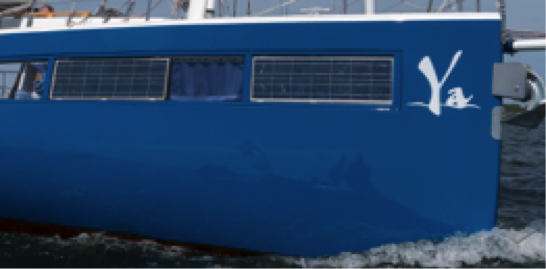
Finally, the Ya has the solar panels along the windows. They are mounted on places you don’t need the sunlight, so behind the anchor box, a cubboard, or storage box.
These panels are the flexible ones and they deliver poorly. But you can get them easy in customized sizes and they are easy to install. We glued them on plastic board and pressed them on to the inside of the windows. They don’t deliver that much, think of some 20 Watts per side, but they look swell and this is much cheaper than any other solar panel.
The alternative would be to incorporate the solar panels in the glass, but such customization becomes very expensive and that does not fit in with the Sustainable Yacht slogan: ‘Everyone sails sustainably”. One must be able to get it ‘from the shelf’, or, if customized, the price must be acceptable.
MPPT, no converter
For efficient charging, use an MPPT, a Maximum Power Point Tracker., instead of a converter. A converter only lowers the voltage of the solar panel to the voltage just high enough to fill the batteries with the current (the Amperes) the solar panels generated. The MPPT converts the voltage that is too high, into amperes for the battery. Very short: the converter delivers the amperes from the solar panels, the MPPT delivers the Watts from the solar panels.
Such an MPPT tracks and computes continuously the voltage. Because a ship moves, and so shades change over the solar panels, make sure you buy an MPPT that can compute fast.
Results, numbers and practice
On a general European winter day with overcast, even the best solar panels (like on the biminitop) deliver… hardly anything. On a general European summers day they all deliver well.
On a warm (sub)tropical day the deck panels get to hot to deliver well, but the thin biminitop panels make that all good.
Flexible panels you can curve, deliver poorly.
Here under you see the rough general numbers when on a regular Transatlantic crossing from the Canaries to the Caribbean.
| Generation | # | Watt | hr/day | kWh/day | Remarks |
| 4,8m2 Solar bimini 3*230Wp | 3 | 216 | 6 | 3,89 | 30% of Wp during 6 hours |
| 3,6 m2 Solar deck 440 Wp | 3 | 88 | 5 | 1,32 | less power due to heat and shadow |
| 2X 1,2 m2 solar windows 2X60Wp | 6 | 18 | 2 | 0,22 | 2 hrs morning+evening op 30% Wp, 50% shadow |
Please donot focus exclusively on the numbers. In our years of experience we learned that the essence lies in the usage (use only what you need), and for the generation in what I call the tripod of energy generation. The solar panels work together with the windmill and the hydrogeneration (prop and alternator). If it is more cloudy, so less sunshine, then there is mostly more wind, so the windmill and/or the sailing speed makes it good. And, when something fails, there is no big problem, like you would have when you depend on a diesel engine.
The (Auto)propellers and alternator
There are three “generators” on board the Ya: the windmill, the solar panels, and the propellors-plus-alternators. This article tells about the alternators and the Autoprops. It is easy to run them, and they always run when doing over 5 knots. Roughly, for 90% of our the sea time the props deliver electricity, for 9% they are not used because of no wind, and only 1% of the time we use it for propulsion.
Under the ship are two propellors, each connected to an alternator. When sailing, the propellors give resistance and start spinning. We switch each electric engine to the alternator function and the alternator delivers electricity to the batteries.
Getting power from a rotating prop is not new. Traditionally this was done by transferring the power of the rotating propeller shaft to an alternator via a pulley and V-belt. We made an article how you make your own propeller and alternator via a pulley and V-belt
However, the propeller, designed to meet its propulsion function, doesnot work that well for generation. Since the forces follow the opposite direction, the blades would have been made differen. Also, the blades and pitch (angle of the blades) would have been made different to meet the slower rotation when it generates.
Also the transfer via the V-belt costs a lot of energy. So we made this more ideal.

The propeller shaft can be seen in the foreground. This comes through the skin on the left (invisible), and ends in the propeller in the water that will turn while sailing.
On the right we see a large pulley, with a V-belt over it, which transmits the turn and accelerates to the alternator (the green round device on top). The faster the alternator turns, the more electricity.
The Autoprops
The best props are large, slow running props. So the 34 foot long Ya has two 16 inch (415 mm) propellors. But for a sailing yacht the drag, the resistance of such big props would be terrible. Close hauled, this drag would lead to a seriously increasing leeway. This is the first reason why the Ya doesnot have fixed props, but 2 Autoprops .
This feathering position is also geat when the speed is to slow anyway to generate well (under 4 knots). When the Autoprops get stopped, they automatically go to the feathering position.
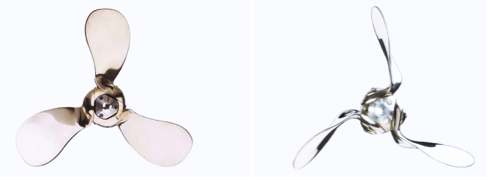
As mentioned before, the blades should have another design if they would be used for generation. Then, the water flow comes from the opposite direction, so the blades should be standing the other way around. The blades of the Autoprops do that. This makes them the ideal generation props. See the movie here below.
Side effect is that these props also give the same thrust when propelling astern.
Also, a fixed propellor is not logical on a yacht, because it is generally designed for 1 speed. And, while the ship is sailing and so the props are in generation mode, the speed always varies; the Ya could go 4 knots with light winds, but also 6 knots with a good running course, of even 7 or 8 when surfing down a wave. It would require continuous adjustment of the blades to make it the most efficient, for generation, but also for propulsion.
Well, the Autoprop arranges this adjustment automatically. When in generation mode, if the speed varies, the revolutions vary, and the blades will vary the pitch to the optimum position and vice versa. And when in propulsion mode, the blades are adjusted by the rotations and the speed through the water. If you look carefully you can also see this in the film here above.
Really nice for long distance sailors, is that it works on natural physics itself: the centrifugal force of the RPMs, and the speed of the boat by the impact of the water on the blades. So no electronics, no chips, wiring, nothing. Just physics. No maintenance, only some grease so now and then. Isn’t it beautiful? It helps the Ya great on its generation.
Want to know more? You find a very thorough explanation with an animation on the Bomarine site (Dutch spoken). The technology for the automatic adjustment is beautiful to make a tech heart running faster. But the economical hearts start running fast when you see the the various tests, where the Autoprop belongs to most efficient props. Yachting did a prop test, or check the German Segeln . Here under the outcomes of the French Voile Magazine.
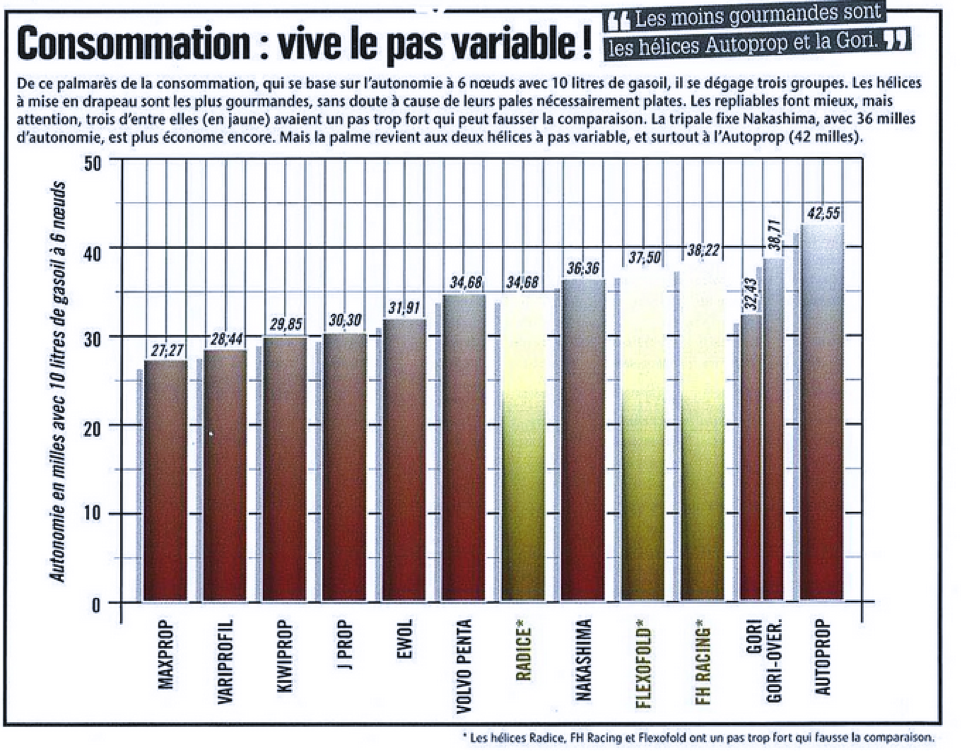
The French magazine ‘Voile’ tested how many miles a yacht could make with 10 litres of diesel. The Autoprop was the best, about 1,5 times better than the most used props.
The alternators
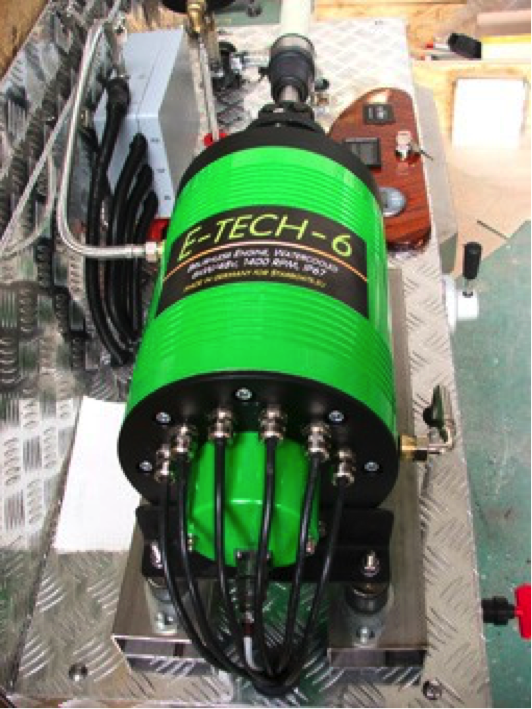
An electric motor with a permanent magnet can easily be switched into an efficient alternator. Just like the old-fashioned bicycle dynamo., the alternator delivers electricity, but much more efficiently. The revolutions do not have to be very high. So you don’t need a reduction box and that saves energy. And a slow rotating propellor is more efficient.
Each of the two 6.5 kW engines can be switched into an alternator with a simple button or a key. These engines/alternators have been chosen for several reasons. These motors are permanent magnet motors and perfectly suited as a alternators. The next things were decisive.
They are brushless. Just like most marine electric motors, they no longer have brushes that “drag” along the rotor. These should be replaced frequently. This applies in particular to the Sustainable Yacht, because they will run in almost all sailing hours: as an alternator (60-70% of the time) and as a motor (10-15% of the time).
Full liquid cooling. Good cooling means that no power is lost to heat.
Double thrust bearing. A thrust bearing is put in between engine and propeller and absorbs the pressure the propeller emits by its drag. This prevents the propeller from exerting its force on the motor itself. A permanent pressure on the engine would cause wear, so this is prevented. Most electric motors only have a thrust bearing on the propulsion side. But on the Sustainable Yacht the engine is usually generated and the power is usually in the other direction. The propellor does not “push”, but “pulls”. The E-Tech engine is therefore equipped with a second thrust bearing.
Synchronous motor. A synchronous motor is ideally suited as a motor and as an alternator. He can, as it were, “flow” into it.
Low maximum rotation. The maximum rotations per minute can be adjusted by the factory. On the Ya the max RPM is only 1040 RPM, with a rather high torque (Nm).
Why slow rotations? There are three advantages: more efficiency, less noise, less wear out.
However, such a motor is more expensive to purchase, so people buy the cheaper one and then use a reduction gearbox. However, due to the gear transmissions, such a reduction means resistance, so less energy to (propulsion) and from (generation) the propellor. Another advantage of the lower revolutions is that all moving parts don’t wear out. A more durable life and a higher reliability.
The practice and the numbers
As soon as we sail more than 4 knots, we give a little reverse power to the engine, and so the Autoprop is ‘soft started’ for generation, and directly we push the Charge switch. We see the RPM display showing about 200. Then the alternator starts doing its work. Inside the cabin you can hear a light, friendly zzzzoooommmm…. The alternator gives electricity in 48 Volt DC to the batteries. This sound is not irritating. It gives peace of mind. A crew member once said: “Alternator, Sweet Alternator” 😉
On 4 to 4,5 knots the energy production is not more than some Watts. But on 5 knots the alternator delivers 50 Watts or more. On 5,5 knots it nears 100 Watt and when doing 6 knots it is 150 Watt. Great fun it is when you surf and reach the hull speed of the Ya of 7.4 knots and make 250 Watts with each alternator.
In general, we are leisure sailors. At sea, especially the ocean, you sail your ship conservatively and for the 33 ft Ya a general speed of 5 to 5,5 knots is fine. Some people find this a high average, but realize that we also have a Parasailor sail. It gives the power of a spinaker, but is easy to handle with two persons, and even when the wind gets stronger you can lower it easily.
Perhaps you find the supply of 100 Watts from the two alternators not much. Well, it is much. This runs 24 hours a day, so count on a 2,5 kWh per day. This is enough to cook an extensive 3 course meal, and cook all water for tea and coffee during the day, and make a bread with the baking machine. We are happy on the Ya, because it is just enough. But it must be said that our speed is critical. I would not recommend to seriously spend money on a prop and alternator for a leisure yacht of 30 feet or shorter, because a cruising speed of 5 knots is not realistic.
In 2012 we collected some statements from electric motor suppliers about the generation possibilities. The impression was created that with a propulsion prop, about 5% of the maximum propulsion power could be generated. That would be 650 watts with our 13 kWatt (2 times 6.5 kW) max power and therefore much much more than our practice on the Ya. But still they can be right: you only need a larger yacht! For example, a 60 ft yacht would easily do 7 or 8 knots, and then the 650 Watt generation is realistic.
The Energy Balance
In the Energy Balance, we assumed values that were achieved by two well-installed propeller shaft alternators with a peak power of 800 watts. These then achieve an average of 30% of this, for 20 hours per day.
| Generation | # | Watt | hr/day | kWh/day | |
| 2 props+alternators 800Wp | 2 | 100 | 15 | 3,00 | On 5,5 knots 100 Watt each; upwind is zero |
As told in the previous article: Please donot focus exclusively on the numbers. In our years of experience we learned that the essence lies in the usage (use only what you need), and for the generation in what I call the tripod of energy generation. The solar panels work together with the windmill and the hydrogeneration (prop and alternator). If it is more cloudy, so less sunshine, then there is mostly more wind, so the windmill and/or the sailing speed makes it good. And, when something fails, there is no big problem, like you would have when you depend on a diesel engine.
Feel free to ask more at info@fossilfreaaroundtheworld.org
